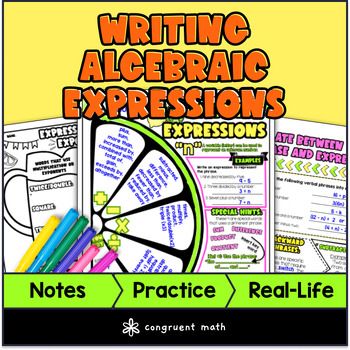Want more ideas and freebies?
Get my free resource library with digital & print activities—plus tips over email.
Join for Free Resources →
$4.25
Have you ever wondered how to teach your 6th or 7th grade students writing algebraic expressions from word problems?
In this lesson plan, students will learn how to write expressions, translate verbal phrases into algebraic expressions and work with expressions that include exponents. This artistic lesson plan includes guided notes (interactive sketch notes), check for understanding questions, and practice with a maze activity as well as a doodle and color by number activity to build understanding.
The lesson culminates with a real-life application where students learn how algebraic expressions help them to model a lemonade stand to make the most profit.

$4.25
After this lesson, students will be able to:
Before this lesson, students should be familiar with:
A fun, no-prep way to practice writing algebraic expressions is Doodle Math — it's a fresh take on color by number or color by code. It includes a vocabulary sheet, 3 levels of practice, and comes with a nature theme perfect for a review day or sub plan any time of year.
Algebraic expressions are mathematical statements that involve variables, constants, and arithmetic operations such as addition, subtraction, multiplication, and division. They are used to represent real-world situations and can be manipulated and simplified using algebraic rules and properties.
Algebraic expressions are mathematical statements that use numbers, variables, and arithmetic operations (such as addition, subtraction, multiplication, and division) to represent real-world situations. Being familiar with common key words associated with addition, subtraction, multiplication, and division will be immensely helpful. They can be manipulated and simplified using algebraic rules and properties.
Exponents are a mathematical notation used to indicate that a number should be multiplied by itself a certain number of times. For example, if you have the expression "2^3", this means that you should multiply 2 by itself three times: 2 x 2 x 2 = 8. The number 3 in this expression is the exponent.
Verbal phrases in algebraic expressions are words or phrases that describe a mathematical operation or relationship. Here are some examples:
Translating verbal phrases into algebraic expressions is an important skill in solving real-world problems using mathematical equations.
To translate a verbal phrase into an algebraic expression, you need to identify the key words and phrases that indicate mathematical operations. This is covered in the Writing Algebraic Expressions Guided Notes.
For example, the phrase "twice a number increased by 5" can be translated to the expression "2x + 5", where "x" represents the unknown number. The word "twice" indicates multiplication by 2, and the phrase "increased by" indicates addition.
If your students need a visual example, I find this Khan Academy video to be helpful:
By breaking down the verbal phrase into its mathematical components, you can create an algebraic expression that represents the situation.
When working with expressions that include exponents, it's important to remember that the exponent indicates how many times the base number should be multiplied by itself. For example, if you have the expression 2^3, this means that you should multiply 2 by itself three times: 2 x 2 x 2 = 8. You can simplify expressions with exponents using rules such as the power of a power rule, power of a product rule, and power of a quotient rule.
Algebraic expressions are highly applicable in various fields, here are some specific examples:
Algebraic expressions can be used to model costs, revenue, and profit in a business, such as a lemonade stand. Here are some example equations:
C = f + v, where f is the fixed cost (e.g. the cost of buying a pitcher and cups) and v is the variable cost (e.g. the cost of lemons, sugar, and water).R = p * s, where p is the price per cup and s is the number of cups sold.P = R - C, where R is the revenue and C is the cost.By using algebraic expressions to model costs, revenue, and profit, a lemonade stand owner can make informed decisions about pricing, production, and marketing strategies. For example, they can determine the optimal price per cup to maximize profit, or decide whether to increase production to meet demand.
Get my free resource library with digital & print activities—plus tips over email.
Join for Free Resources →